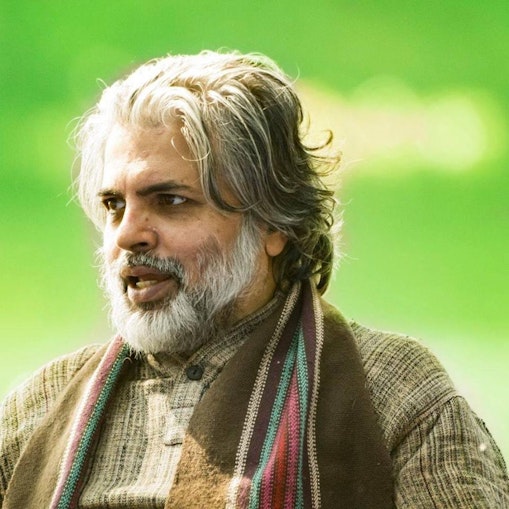A view from Chittagong
Alam Khorshed
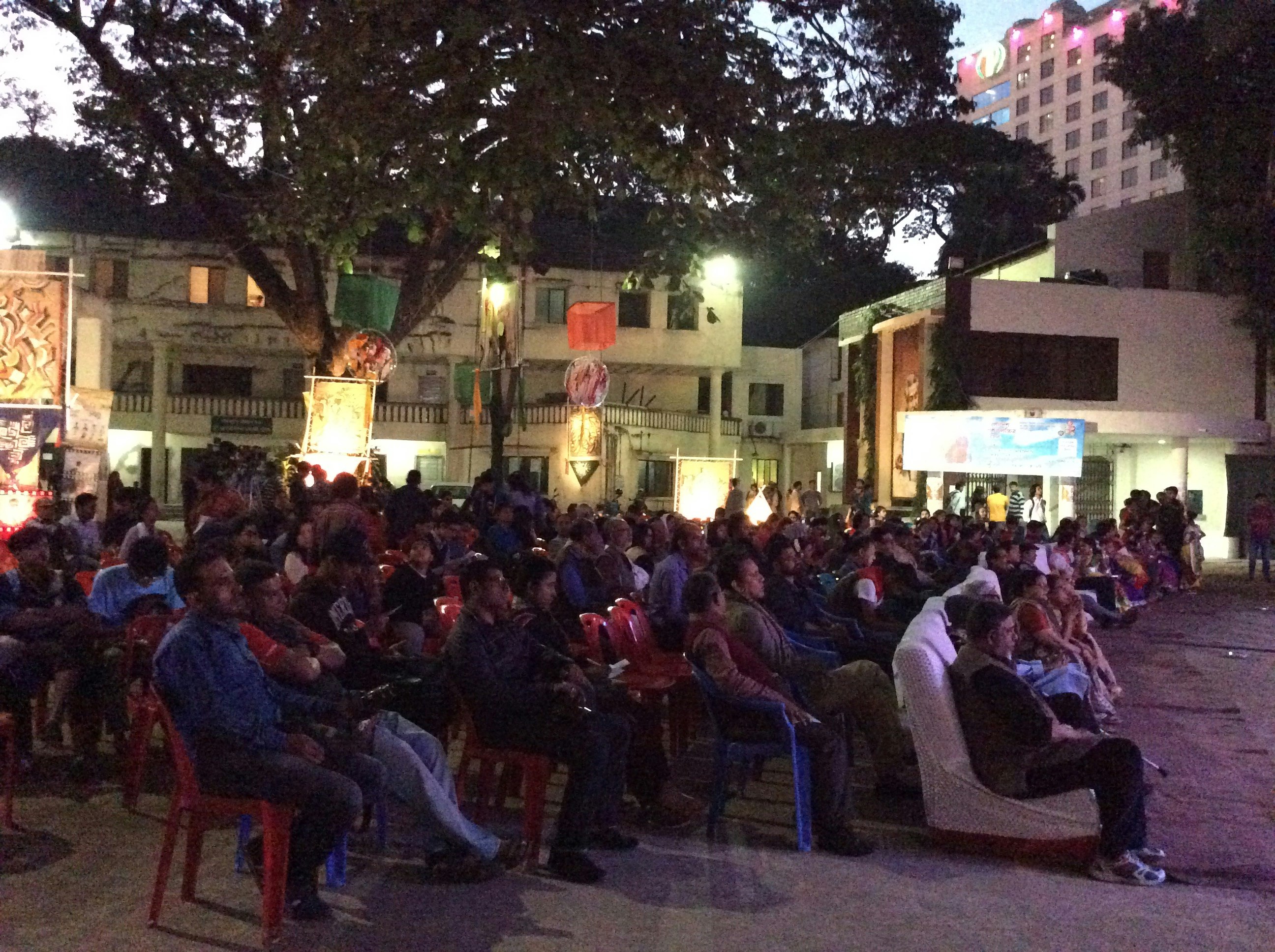
Audience at Bistaar Arts Festival ’17, Shilpakala Academy Chittagong, 28–30 December 2017; photo courtesy Shoeb Imran.
In February 2018, following attendance at Dhaka Art Summit’s fourth iteration in the Bangladeshi capital, I travelled east to Chittagong where over several days I aimed to experience as much as I could of the city’s burgeoning art scene, meeting artists, art organisers, curators, critics, teachers, writers and filmmakers. After a morning at Santaran Art Organization’s base within a small-scale agricultural allotment in the city’s outer area near its airport, accompanied by engaging discussion with its resident artist organisers including Meherun Akter, I made my way to Bistaar: Chittagong Arts Complex, by far the city’s most prominent arts and cultural space. It was there that I met Alam Khorshed, Bistaar’s founding director, whose immediately engaging intellect and generous hospitality ensured that my visit was indeed fruitful. Following a tour of Bistaar’s spaces and an introduction to its activities, Khorshed took the initiative of introducing me to Shaela Sharmin, artist and Director of the University of Chittagong’s Institute of Fine Arts, who along with her colleague Associate Professor Mohammad Jashim Uddin, likewise led me on a fascinating tour of the Institute’s campus and many artists’ studios and workshop rooms. The following evening, Khorshed invited me to a film screening and discussion event at Bistaar in which Sohel Rahman, a Chittaong filmmaker based in Lisbon, presented two short films to an engaged local audience. This conversation took place over email in October 2018.
— Editor
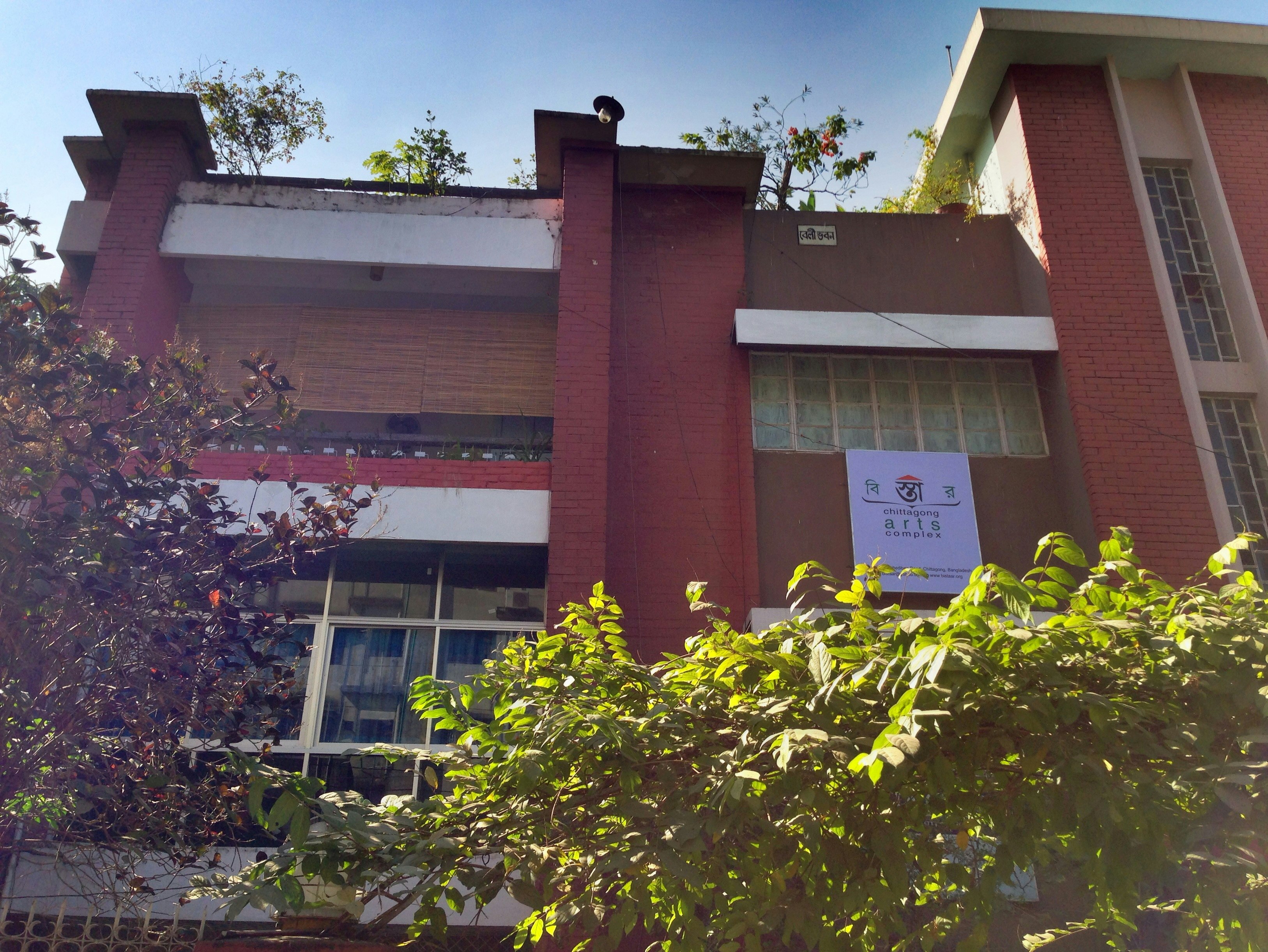
Exterior view of Bistaar: Chittagong Arts Complex, December 2014; photo courtesy Rashedul Alam.
Pedro de Almeida (PDA): What were your motivations and aspirations in founding Bistaar: Chittagong Arts Complex in December 2014?
Alam Khorshed (AK): Actually, even before founding Bistaar, I used to run another organisation named Bishaud Bangla, meaning ‘all things Bengali,’ which was basically a small platform for the preservation, propagation and promotion of local arts, crafts and heritage of Bangladesh. Even though it was basically an arts organisation, it simultaneously operated quite a few income generating projects under the same roof merely for its economic independence and sustenance. But after running for nearly eight years with much success, we realised that due to our divided attention to both commercial and artistic activities, at one point the latter started to suffer and show signs of stagnation. After some serious soul searching along with long discussions and deliberations, we finally decided to curtail the business part of it and transform this into a fully-fledged, publicly supported ‘arts centre’ in Chittagong.
Until then, there was no such thing around, and the city indeed needed a professionally run, broad based ‘arts infrastructure,’ which would meet the long-overdue demand of the art practitioners and the art aficionados of the town. Chittagong is one of the fastest growing cities in the world, teeming with a rising tide of youth who are full of creative ideas and a thirst for artistic activities. And yet there was no place in this busy international port city that exhibited a range of quality arts programs on a regular basis. We thought of filling this void ourselves by creating a physical space in order to expand into a meeting place of the creative personnel and a permanent platform for holding substantial arts activities all year around. Eventually, we took the plunge in the year 2014 to realise our original vision and broaden it into a true arts centre called Bistaar: Chittagong Arts Complex dedicated to practicing and presenting local and international arts while nourishing the creativity of the young and upcoming artists of the region.
PDA: How would you define or describe contemporary artistic practice, across various art forms, in Chittagong today?
AK: Frankly, the contemporary artistic practice across various art forms in Chittagong is not too encouraging. Among all the disciplines, only in the visual arts arena we can discover some fresh thinking, new ideas, innovative approaches and a sincere effort of bridge-building with the contemporary international art scene at large. A couple of visual art organisations of Chittagong, namely Jog Arts Space and Santaran Art Organization along with a few individual artists are at the forefront of this change-making practice. Most other sectors, like theatre, film, music, dance etc. are still treading on the beaten path. These are struggling to find a newer and more contemporary language and voice of their own in order to break away from the old mindset and all too familiar, hackneyed modes of production and formats of presentation of their artistic endeavour, barring a few noble exceptions of course.
Chittagong is one of the fastest growing cities in the world, teeming with a rising tide of youth who are full of creative ideas and a thirst for artistic activities.
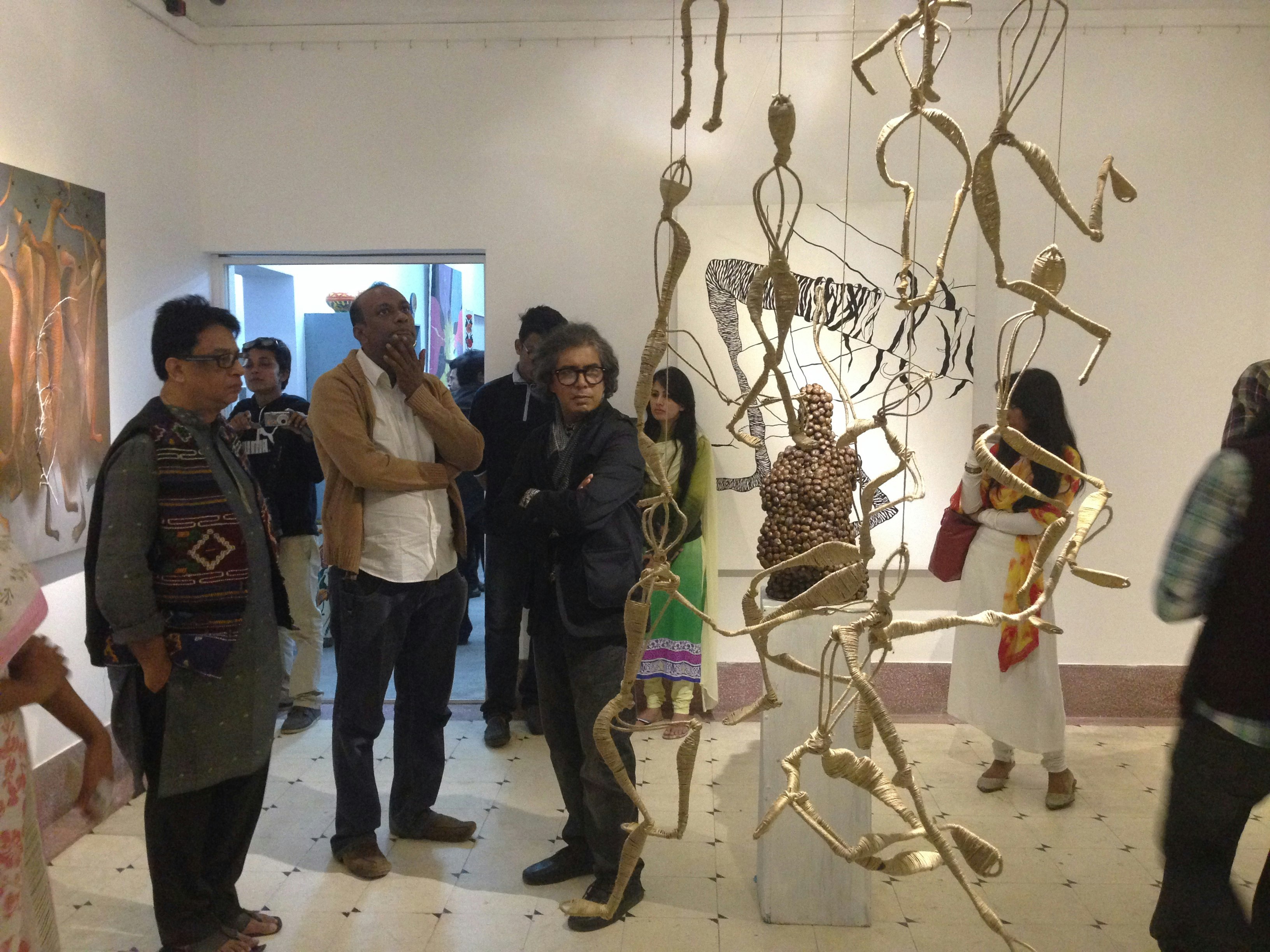
PDA: What were the principle challenges you faced in getting Bistaar up and running? How was it initially received by the local arts community and further afield in Bangladesh, particularly artistic circles in Dhaka?
AK: The very first challenge was of course financial. In order to overcome that challenge, we came up with an entirely new and rather untested idea, namely crowdfunding. With the initial assistance of a Croatian-American educationist, Annie Polatsek, working in Chittagong during that time, and a great admirer of our work at Bishaud Bangla, we launched an internet-based ‘crowdfunding campaign’ in the summer of 2014, I believe the first ever such campaign in Bangladesh. And guess what? Our campaign was a great success and we were able to raise our target for seed money in just two months thanks to the generosity of 165 donors spanning 15 countries. The second challenge was to set up the steering body, the Board of Trustees to be more precise, motivated and dedicated enough to undertake a difficult task like this. I persisted on my relentless persuasion and finally prevailed to build a strong and competent team worthy of the challenges ahead.
Not surprisingly, Bistaar was well received right from the beginning despite some lingering confusion about our previous identity as Bishaud Bangla and the nature and future course of action of the new incarnation. But by the very look and ambiance of our new space, and quite a few interesting activities in quick succession combined with an exciting calendar of future events, we were able to dispel that confusion and win over the sceptics soon. The artistic circles in Dhaka and other regions of Bangladesh were equally enthusiastic and positive in their response, which was quickly translated into number of fruitful creative collaborations between us and a steady stream of visits by the arts lovers and practitioners from all over the country.
PDA: When I visited Bistaar, you were kind enough to invite me to meet Shaela Sharmin, the Director of the Chittagong University’s Institute of Fine Arts, who in turn lead me on a tour of the campus and artists’ studios. Have many students or alumni of the institute presented work with Bistaar? More broadly, what is the relationship between Bistaar and other key arts organisations and institutions in Chittagong?
AK: Bistaar: Chittagong Arts Complex started its artistic journey on 29 December 2014, the birth centenary of Zainul Abedin (1914–1976), the universally revered father figure of the modern art movement of the country. In order to mark the day, we had invited the graduating students of Chittagong’s Institute of Fine Arts to present a group exhibition as a tribute to the maestro, curated by a young faculty member of the same Institute. This practice of creative collaboration with the Institute still continues fairly regularly, resulting into a number of other exhibitions and presentations by the teachers and the students of the Institute during the following years of our existence.
The relationship between Bistaar and other major arts organisations of the city is quite friendly, positive and productive. On many occasions, Bistaar collaborated with these organisations in presenting workshops, events, festivals and other artistic activities. Of course, there is room for further improvement in this regard, particularly in terms of the number of participants from these organisations in our regular activities like exhibitions, film screenings, workshops etc. We would be really happy if more students of the Institute of Fine Arts especially made use of our space and platform to enhance their artistic pursuit and creative education by making more frequent visits and collaborative engagements.
The artistic circles in Dhaka and other regions of Bangladesh were equally enthusiastic and positive in their response, which was quickly translated into number of fruitful creative collaborations between us and a steady stream of visits by the arts lovers and practitioners from all over the country.
PDA: Tell me about your professional background. What were the key experiences and influences throughout your career that led you to want to establish a platform for contemporary arts in Chittagong? What was your prior connection to the city and the wider region?
AK: I was born in a village in Comilla district, situated roughly in between Dhaka and Chittagong, but moved to Chittagong with my parents at a very early age, where I finished my primary and secondary education. Later, I was trained as a Mechanical Engineer in the University of Engineering and Technology, based in Dhaka. I worked for a few years in a leading multinational company in Chittagong before moving to North America, first for higher studies and then to work for few tech organisations in New York and Montreal. All the while, I continued my career as a non-fiction writer, critic and translator, publishing books from Bangladesh on a regular interval.
During my university years in Dhaka, I was actively involved with a prominent theatre group as an actor, with several film societies as an activist, and with television as a debater and presenter. Apart from this, I was also closely associated with the visual art scene of Dhaka during the 1980s, particularly with a group named Somoy, spearheading a contemporary and conceptual art movement in Bangladesh, many of whose members are now leading visual artists and art organisers of the country. These closely related and largely conducive interests, activities and experiences of mine must have shaped my mental faculties and creative temperament to persuade me to dream and build a quality arts centre in my virtual hometown, Chittagong.
PDA: How does Bistaar devise its program? What kinds of considerations are at play, artistic as well as practical?
AK: Actually, we don’t have a fixed method or procedure to plan our programs and prepare Bistaar’s calendar of activities. There is a general guideline though, and we try to work around it to attain the maximum fulfilment. We have, however, a few regular program series such as fortnightly film screenings, a quarterly visual arts exhibition, an annual arts festival, a biennial documentary film festival, etc. We often receive proposals from artists of all domains to showcase their work, performance and so on under Bistaar’s banner. We try to accommodate as many as those possible, provided they meet our quality and eligibility criteria and are feasible within our limited budget. Sometimes, we ourselves approach and invite certain individuals and organisations to come and show their work under our own auspices. No doubt, this is quite an innovative and original way of programming events which has its own challenges and uncertainties, but so far it has worked fine. The bottom line is we never compromise with quality and always look for new, exciting, fresh and meaningful arts activities to present to our audience.
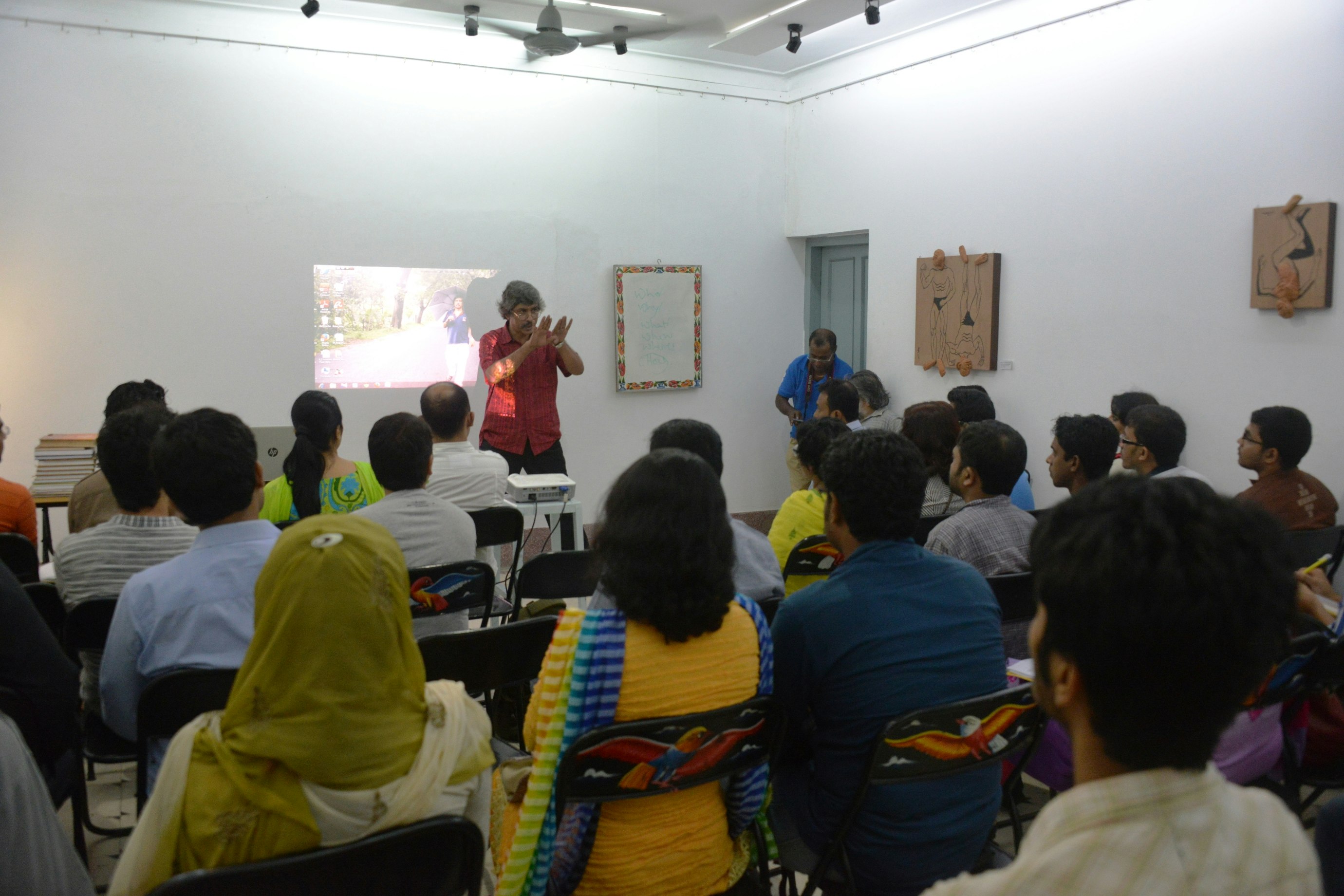
Literary workshop by writer Abu Hasan Shahriar, July 2015, Bistaar: Chittagong Arts Complex; photo: Shahriar Farzana.
PDA: What have been some of the program highlights for you? For instance, is there an exhibition, presentation or project that was especially exciting or generated outcomes beyond your initial expectations?
AK: The annual arts exposition, popularly known as Bistaar Arts Festival (BAF), that showcases a series of exciting arts from all the domains, in an outdoor open stage in front of a huge crowd from all quarters, is certainly a major highlight of our achievements so far. The accompanying visual arts exhibitions of this festival also tend to generate tremendous interest among the commoners who usually don’t have access to this kind of display of exclusive artworks. We also consider our biannually organised Traveling Film South Asia (TFSA) documentary film festival to be a great accomplishment of Bistaar, if not in terms of the audience per se, but certainly for the kind of strong and discernible impact it has created on the minds and understanding of the young and upcoming community of filmmakers in Chittagong. A day-long workshop on animation and cartoon drawing conducted by a popular cartoonist of the country was another remarkable event as all the sits filled up quickly and we had to turn away a lot of enthusiastic candidates, which was beyond our expectation.
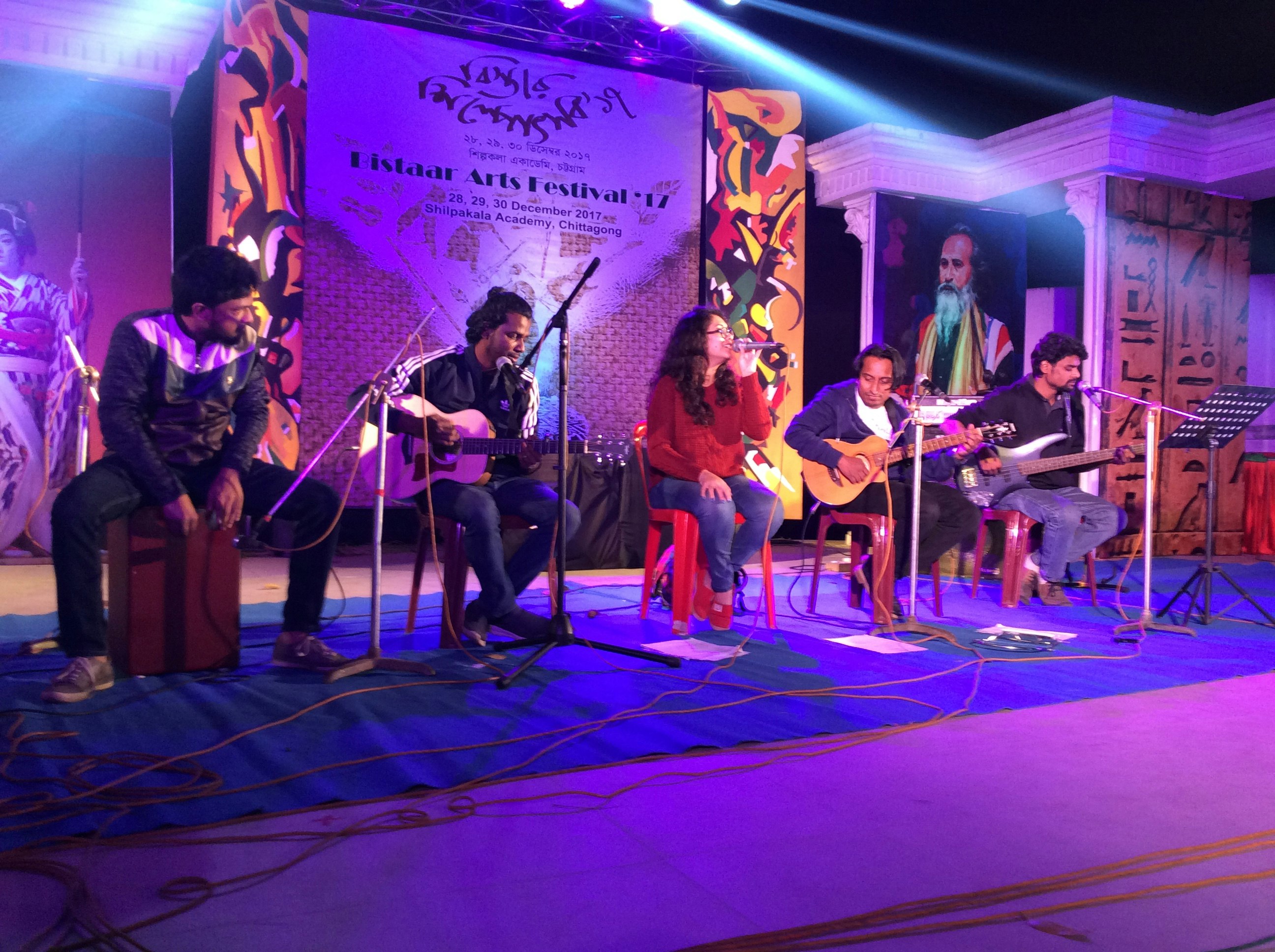
Musical performance, Bistaar Arts Festival ’17, Shilpakala Academy, Chittagong, 28-30 December 2017; photo: Masum Pervez Imon.
PDA: I am aware of Bistaar’s work beyond the boundaries of the walls of its building, for instance festivals and other activities in the public realm. What are the dynamics of producing and presenting work in public spaces in Chittagong? What kind of audiences do you attract and hope to attract?
AK: Yes, we do and want to do more outdoor events for the larger population of the town. But, the unpalatable ground reality is that, Chittagong has very few facilities like an auditorium, gallery, meeting hall, etc. to hold our proposed extramural events. The facilities we do have in the city are also not in good shape and are not appropriate and adequate to present certain kinds of programs. On top of this, their allotment and entitlement to access are usually controlled rather arbitrarily by a few influential individuals or a so called ‘committee’, making it extremely difficult and at times almost impossible to find a suitable venue for our planned events during certain preferred dates and days of the week, month or year. Apart from this serious crisis of venue, one is always faced with some administrative restrictions, along with many limitations in terms of logistical support which often makes it difficult to plan and execute our large-scale outdoor events. However, there is one piece of good news: the central government has recently undertaken a project to build a huge cultural complex in the heart of Chittagong comprising several auditoriums of varying capacity complete with all necessary supporting ancillary facilities. But that will take at least three to five years to be completed.
Bistaar’s stated mission is to reach out to the general population of the city and offer them good and quality arts events all year round as a means of both entertainment and educative experiences. We want audiences from both the younger generation and the more matured members of the community, including the retired senior citizens, thus building an artistic bridge across the generations. We want to break away with the current stagnant scenario of few familiar faces everywhere in city’s art sphere and bring in new people with new orientation and expectation in order to create and build a newer, more open minded audience of our arts.
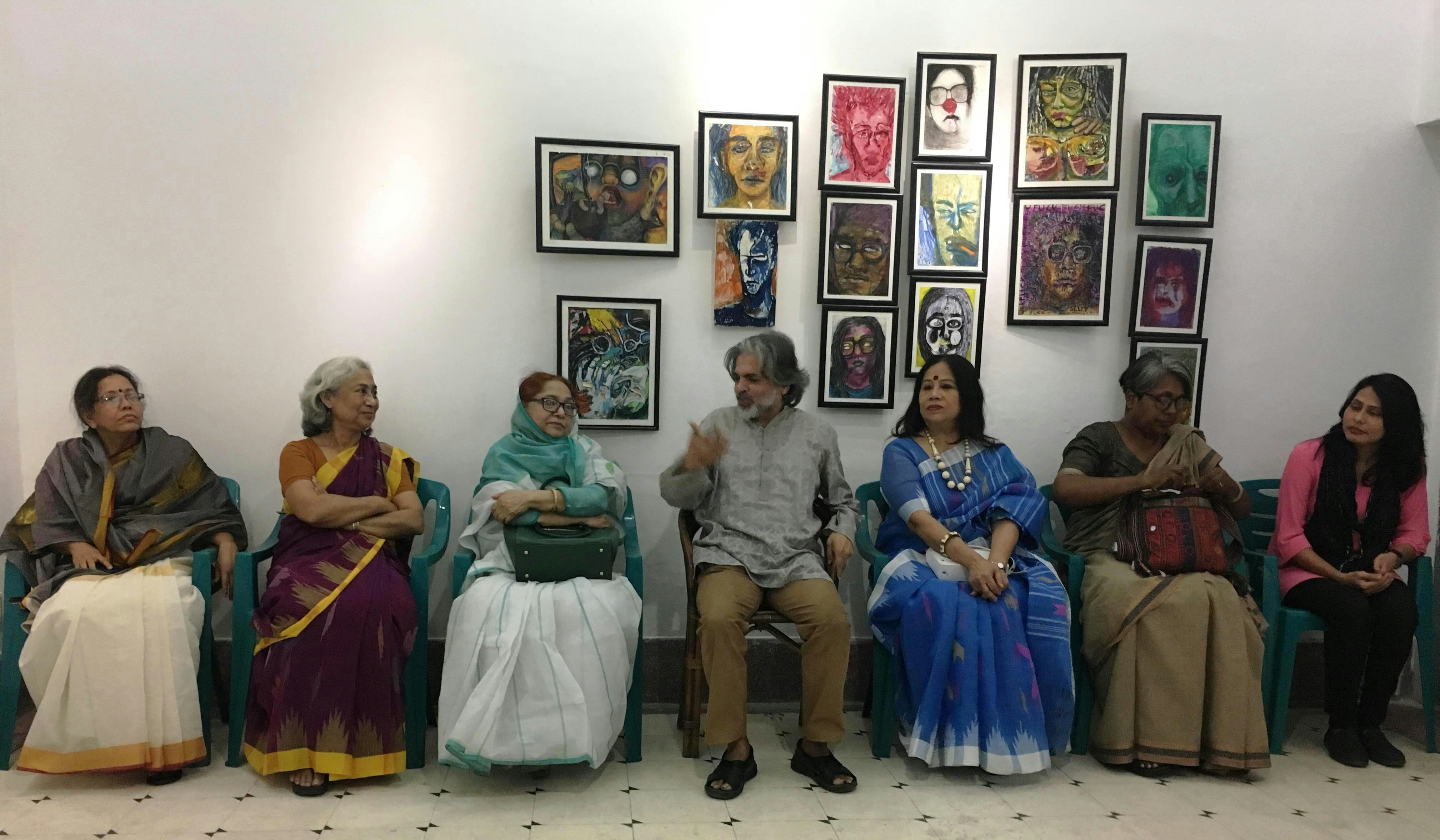
Celebration of International Women’s Day, March 2017, Bistaar: Chittagong Arts Complex (with Director Alam Khorshed, centre); photo: Mishuk Ehsan.
PDA: What sort of impact has Dhaka Art Summit (DAS) had in generating more local as well as international interest in Bangladeshi art? For instance, how much of a drawcard is DAS for artists based in Chittagong—do many travel to Dhaka to experience DAS? Does visitation of DAS by international artists, curators, museum directors and others have an impact in Chittagong? And more broadly, how distinct (or not) do you regard the arts and cultural spheres of both cities, Dhaka and Chittagong?
AK: I think DAS was quite successful in generating more interest in and enthusiasm for Bangladeshi art, both among local and international audiences. This was particularly noticeable in the steady, and at times overflowing, stream of Dhaka populace visiting the myriads of exhibitions hosted during the Summit. Also, the sheer number and stature of the international artists, critics, curators and collectors attending the Summit is a clear indication of their interest and curiosity for contemporary Bangladeshi art. But unfortunately, according to my observation, not too many artists and art lovers from Chittagong actually make the trip to Dhaka to view the exhibitions first hand, whatever may be the reason behind this. Consequently, the visitation of DAS by the international artists and all don’t seem to have much of an impact on the art scene of Chittagong.
On another note, the arts atmosphere and cultural practices of Dhaka and Chittagong tend to differ mostly in one aspect, namely professionalism. While Dhaka artists and arts organisers are becoming more and more professional in their attitude and approach, the Chittagong arts scene still seems to be driven by pure passion, individual emotion and impulses, which is often manifested in the crude and casual nature of it, on the one hand, and its simplicity and spontaneousness on the other.
PDA: Apart from the necessary need for increased financial investment from government, commercial and private supporters of the arts, what do you feel Chittagong needs or must overcome to further develop its artistic scene?
AK: In fact, a lot needs to be done to develop and enrich the overall arts scene of Chittagong. First and foremost: the burgeoning civil society must be mobilised to embrace and nurture arts in their daily lives, both in personal and social spheres, and become more proactively engaged in support of arts. We also have to reach out to the elementary schools of the city to encourage the authorities to bring more arts to their students and to include more creative activities in their curriculum. And speaking about the curriculum, I think Chittagong’s Institute of Fine Arts and other creative arts departments of different city universities should revise and update their teaching methodologies and materials to better equip their students in keeping pace with the rapidly changing world of contemporary arts.
In my view, the local print and electronic media should also be persuaded to put more emphasis on arts news coverage and play a positive and constructive role in highlighting arts and cultural happenings of the city, along with undertaking a constant campaign for popularising arts in every segment of life. Additionally, in the short term, a very well designed and professionally executed, large-scale national/international arts event taking place in town on a regular basis will surely have a tremendous positive effect on the overall upliftment and wellbeing of the Chittagong art scene.
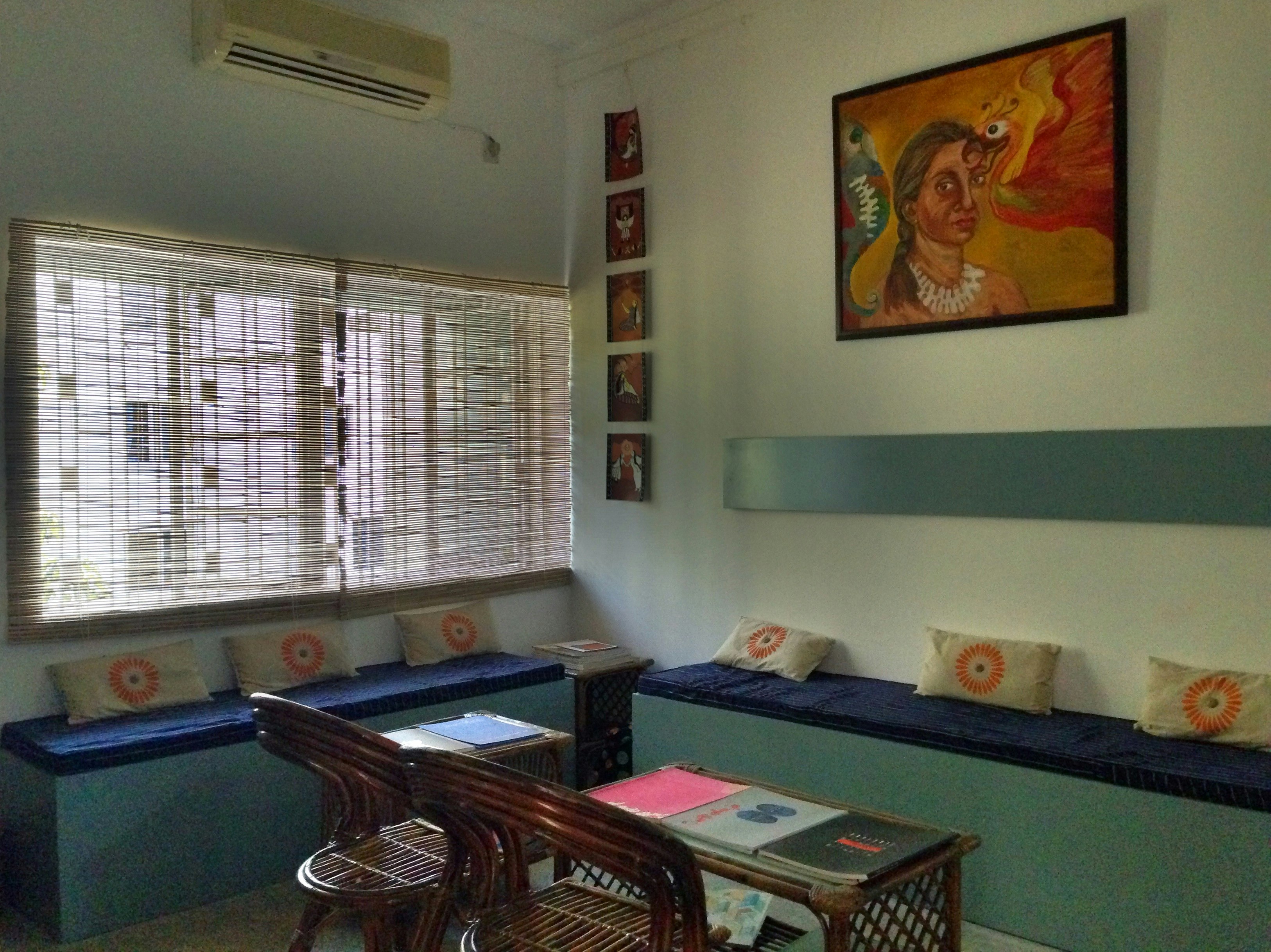
Resource Centre, Bistaar: Chittagong Arts Complex, December 2014; photo: Mahia Abrar.
PDA: What are your aims and hopes for Bistaar over the next five years?
AK: In next five years, Bistaar dreams of securing its own permanent address and a well designed infrastructure of a genuine and complete Arts Complex in or around the city. Simultaneously, it aspires to become an active, professionally run, self-sustainable and high quality international institution of contemporary arts.
About the contributor
Alam Khorshed (b. 1960) founded Bistaar: Chittagong Arts Complex in December 2014 and has been working as the Founding Director of it since.
